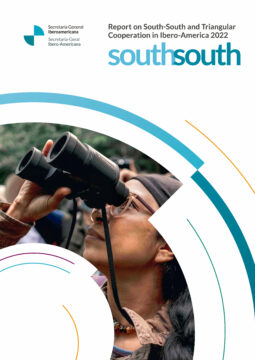The non-Ibero-American Caribbean region: a strategic partner for Ibero-American South-South and Triangular Cooperation
The non-Ibero-American Caribbean has historically been the region on which Ibero-American countries have focused their South-South and Triangular Cooperation.

Between 2015 and 2021, Ibero-American countries participated in 438 South-South and Triangular Cooperation initiatives together with non-Ibero-American Caribbean nations, exercising different roles. These correspond to 33 programs, 254 projects and 151 actions. Seventy percent of these are Bilateral exchanges, 19% are Regional and 11% are Triangular. In this sense, the proportion of Regional initiatives with the non-Ibero-American Caribbean is higher than Regional SSC’s share in Ibero-American cooperation as a whole (6% for the same period). This seems to be explained by the geographic proximity and by the fact that countries share some regional problems that require shared solutions, which search is often supported by the different multilateral organizations to which they belong (for example: ACS, CARICOM or SICA).
The first of the graphs below shows that, since 2018, the total number of initiatives with the non-Ibero-American Caribbean has fallen. However, this was also the case of all Ibero-American South-South and Triangular Cooperation. As a result, the percentage over the total has remained stable (around 10%). Likewise, the distribution by type of instrument has varied over time and, in 2020-2021, the proportion of actions is higher than that of projects and programs, which seems consistent with the response to the COVID-19 pandemic.
Graph 1. Evolution of Ibero-American South-South and Triangular Cooperation initiatives with the non-Ibero-American Caribbean by type of instrument, percentage overall South-South and Triangular Cooperation with other regions’ developing countries and percentage overall Ibero-American cooperation. 2015-2021
In units and percentage

Source: SEGIB based on Agencies and Directorates-General for Cooperation.
In sectoral terms (see the second graph), cooperation with the non-Ibero-American Caribbean mainly focused on Health (22%), a sector that has a higher importance than in South-South and Triangular Cooperation as a whole during this same period. This is also the case of Disaster management and Education, which rank second, together with Agriculture and livestock (9%), while their incidence is 3.6% and 6.1% in overall cooperation, respectively. In contrast, although Agriculture and livestock and Strengthening institutions and public policies concentrate a large number of initiatives (9% and 6% respectively), they have had a lower share than in Ibero-American South-South and Triangular Cooperation as a whole between 2015 and 2021 (12% and 8%).
Graph 2. Sectoral distribution of Ibero-American South-South and Triangular Cooperation initiatives with non-Ibero-American Caribbean countries. 2015-2021
In percentage

Source: SEGIB based on Agencies and Directorates-General for Cooperation.
The third graph portrays non-Ibero-American Caribbean countries’ participation in the cooperation between the two regions. Belize has been, by far, the most important non-Ibero-American Caribbean country, participating in 32% of the initiatives executed in the period. In fact, Belize has been involved in almost 70% of the regional programs that include the non-Ibero-American Caribbean. This can certainly be explained by its membership in SICA. Belize is followed by Haiti, which has participated in a quarter of the initiatives. In addition, cooperation has been implemented during the analyzed period with other 14 Caribbean countries and, even the least active (Bahamas), has participated in 28 initiatives, which also reveals the dynamism of this relationship.
Graph 3. Participation of Ibero-American countries in South-South and Triangular Cooperation initiatives with the non-Ibero-American Caribbean, by type of instrument. 2015-2021
In units

Source: SEGIB based on Agencies and Directorates-General for Cooperation.
Finally, the fourth graph shows the participation of developing countries in Ibero-America. Three of these stand out for their geographic proximity and clear interest in South-South and Triangular Cooperation with the non-Ibero-American Caribbean: Mexico, Colombia and Cuba; not only as providers but also in other roles. These are followed by all the Central-American countries in addition to the Dominican Republic. Chile and Argentina should also be highlighted as providers.
Graph 4. Participation of non-Ibero-American Caribbean countries in South-South and Triangular Cooperation initiatives with Ibero-America, by role. 2015-2021
In units

Source: SEGIB based on Agencies and Directorates-General for Cooperation.
July 2023
***
Source: SEGIB based on Agencies and Directorates-General for Cooperation.
Photograph: Regional SSC project “Strengthening the Biological Corridor in the Caribbean” with the participation of the Dominican Republic and Cuba. Image bank on South‑South and Triangular Cooperation in Ibero‑America. SEGIB‑PIFCSS. 2022.

